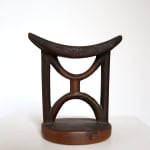Anonymous Mfinu artist
Headrest
D.R. Congo
Late 19th century
Wood, metal
Late 19th century
Wood, metal
height 16 cm
height 6 1/4 in
height 6 1/4 in
Copyright The Artist
Sold
Further images
Only one other headrest of this type is known, it was auction in Dijon in 20216 (Sadde, 2 June 2016, lot 155), where it was sold for more than 50...
Only one other headrest of this type is known, it was auction in Dijon in 20216 (Sadde, 2 June 2016, lot 155), where it was sold for more than 50 times its low estimate, signaling its exceptional nature. A few later the present headrest was discovered by its current owner, an important art-historical event seen the rarity of the type. `The type in fact is very similar to a group of Mfinu headrests of a more angular nature – the most emblematic of them having become the logo of the Dapper Foundation (previously the Musée Dapper in Paris). Five such headrests are known, one in the Brooklyn Museum (22.811), the Dapper example (0926), an example in the Tervuren Museum, one in the Willy Mestach collection, and a last one privately owned and sold at Binoche & Giquello in Paris in 2016 (10 May 2016, lot 47). The middle section of these headrest similarly has a most anthropomorphic feeling, with stylized arms and legs connecting the top with the bottom. These headrests have a central support column, connecting the top with the base, opposed to the present where two lateral columns form the actual structural support of the rest. Christiane Falgayrettes, writing about the example in the Dapper Foundation: “Headrests sometimes contain pure lines that seem to emerge from the depths of human memory, revealing mankind’s body in its earliest fullness. Its image appears fleetingly or is barely sketched out, like in Shona and Mfinu works; the composition is simple, with geometric planes and the elimination of all superfluous detail leading to the synthesis of elements that are the visual basis of the metaphor. Few sculptors have been able to achieve, as in these works, such a degree of stylization without sacrificing the vitality in the general structure”. (‘Supports de rêves’, Paris, 1989, p. 55) Marc Leo Felix has pointed out that a few Teke groups lived among the Mfinu, which could indicate that this type of work, with its strong Teke influence, was sculpted by one of their members (‘100 peoples of Zaire and their sculpture ’, 1987, p. 113).
Provenance
Colonial collection, Belgium
Peter Biesmans, Bilzen, Belgium
25
of
25











